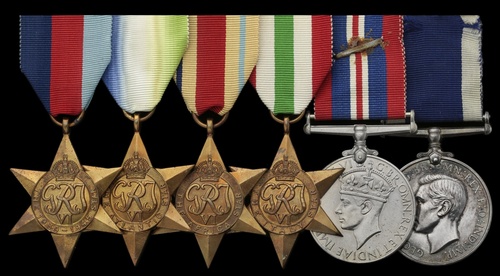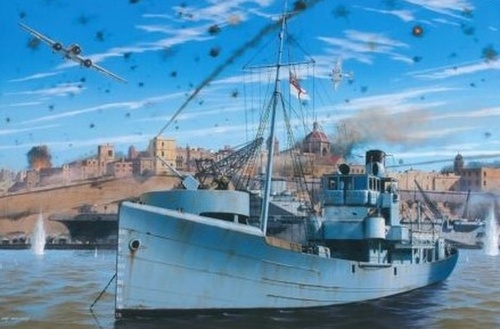Auction: 22003 - Orders, Decorations and Medals
Lot: 408
MALTA 1941-43: OPERATION "PEDESTAL" ET AL
A Second World War siege of Malta group of six awarded to Chief Petty Officer J. F. E. Tubb, Royal Navy, who won a 'mention' for his gallantry aboard the armed trawler H.M.S. Beryl - otherwise known as the 'flagship of Malta'
1939-45 Star; Atlantic Star; Africa Star; Italy Star; War Medal 1939-45, M.I.D. oak leaf; Royal Navy L.S. & G.C., G.VI.R., 1st issue (J. 101813 J. F. E. Tubb, P.O., H.M.S. Pembroke), good very fine (6)
John Frederick Ernest Tubb was born in Fulham, London on 16 November 1905 and entered the Royal Navy as a Boy 2nd Class in April 1921.
Following service in the river gunboat Sandpiper on the China Station in the mid-30s, he was advanced to Petty Officer and was awarded this L.S. & G.C. Medal in October 1938.
In August 1939, Tubb joined the armed trawler H.M.S. Beryl and he was to remain similarly employed until August 1943, thereby sharing in the many honours she accrued during the siege of Malta.
For his own part, in carrying wounded to cover and rendering first aid during repeated attacks against the Beryl on 29 December 1941, he was mentioned in despatches (London Gazette 26 May 1942). The relevant recommendation refers to five waves of German fighters carrying out the attacks and the trawler's Lewis gunner and Telegraphist were likewise commended for their courage.
But this was but one incident in a protracted period of sterling service, a gallant story best summarised by Paul Lund and Harry Ludlam in Trawlers Go to War:
'Over at Malta in the meantime, the trawler Beryl had become the Navy's lone bulwark in the long and bitter siege of the island. Beryl was an old hand at work in the Mediterranean. She had been bought by the Admiralty in the mid 1930s and sent out on the Abyssinian Patrol. The outbreak of war found her at Malta under the command of a warrant officer of the Royal Navy, Boatswain Victor Rhind. As the island came under siege both of Beryl's sister ships, Jade and Coral, were wrecked early in 1942 by the enemy bombers which raked the island, but Beryl went on to weather the siege and win the same sort of reputation and undying admiration of the islanders as the three aircraft which were all the local defence available at one time. The islanders called her 'the flagship of Malta', for she flew the flag of the Flag Officer, Malta, when there was no other naval ship afloat.
Beryl's first big exploit involved a merchant ship which she found bombed and on fire. Despite continued attacks by enemy planes, Beryl rescued the crew and stood by, trying to put out the flames, but the blaze had taken, too big a hold. Nevertheless, she fought the fire until it was too dangerous to stay near.
She next took part with minesweepers in bringing the heavily damaged and blazing tanker Ohio into harbour. Though attacked by aircraft for four days, the crippled Ohio, making hardly any speed and looking all the time as though she would crack in half, was finally brought into harbour. The Ohio, after her epic run, was a total loss.
One of Beryl's trickiest jobs at the height of the siege was as mark ship for a mine laying cruiser which used to dash for Malta to run in supplies; the trawler would wait for the cruiser at a buoy to lead her in. One night while Beryl waited, five E boats spurted out of the dark to attack her. Cannon shells splintered her bridge and wheelhouse, but she evaded all the enemy torpedoes and came back strongly with her limited armament her strongest gun was a three inch for'ard. She sank one of the enemy boats and damaged at least one other, and the rest turned tail. Because of this enemy activity Boatswain Rhind decided to lead the cruiser into harbour by the inshore route, even though there was a danger of mines. It was remarkable foresight and good luck on his part, for in the morning they found that enemy mines had been strewn down the other, 'swept' channel and the cruiser would have been a certain victim.
Beryl also met and guided in British submarines which sneaked into Malta to land vital supplies of oil and food, patrolling watchfully for U boats and E boats while they were discharging.
When an ammunition ship was bombed and set ablaze in the harbour Beryl attempted to save her. Braving repeated attacks by enemy planes she went alongside and tried to fight the fire, but the decks of the stricken ship were red hot and burned through all the hoses that were put aboard her. Finally a Lieutenant went aboard her and carried out scuttling work to ensure that she sank without blowing up, an exceedingly dangerous task for which he earned the George Cross.
As the only warship to serve day and night throughout the siege of Malta, Beryl had many narrow escapes. Just one instance of her charmed life was when an aircraft carrier was in harbour and the naval authorities foxed the enemy by moving the carrier to a new anchorage. Unluckily for Beryl her berth for the night was near that previously occupied by the carrier, and when the enemy swooped over to the attack she found herself the centre of a hailstorm of bombs; but miraculously she escaped with her stern riddled with bomb splinters.
When Malta was relieved Beryl's work was still not ended. She laid the buoy, which guided the small landing craft to shore on their invasion of Sicily. Later this buoy, at the end of the Malta swept channel, was used for the rendezvous with the Italian Fleet which surrendered and was laid up in St. Paul's Bay, Malta; Beryl met the ships and led them to the anchorage.
She also helped on experimental work with two man submarines in a bay at Malta, 'pinging' the bay with her asdic while the miniature subs tried to get in and stick a mine on her. Exercises completed, she would hoist the two man raft on to her deck and ferry it home to base. Yet another duty found her as a survey ship when the various harbour and approach hazards were plotted by the hydrographical officers of Malta. Towards the quieter days in the Mediterranean she took on convoy work up to Italy.
Though she had many changes of First Lieutenant, Boatswain Rhind remained her captain. He was dedicated to his ship and must have spent more hours on the bridge than any other commanding officer in the Navy, for on Beryl, with only two officers, it was always, at best, watch and watch; and in action, watch on and stay on.
Rhind, who was awarded the D.S.C., was a quiet man who seldom mixed much when ashore, although he had friends in the dockyard whom he visited. He was very proud of his position, and of his ship and her record, but he never spoke of his exploits, which accounts for Beryl never having received her due, though her logbook showed her to have been in everything, and sometimes as the leading light. She was in commission in the Mediterranean longer than any other ship in the Navy.'
Tubb - who was advanced to Chief Petty Officer in May 1943 - was invalided ashore in February 1946. He died on the 26 June 1985.
Sold with a quantity of uniform rank insignia and a wartime H.M.S. Pembroke cap tally.
Subject to 20% VAT on Buyer’s Premium. For more information please view Terms and Conditions for Buyers.
Sold for
£320
Starting price
£160







